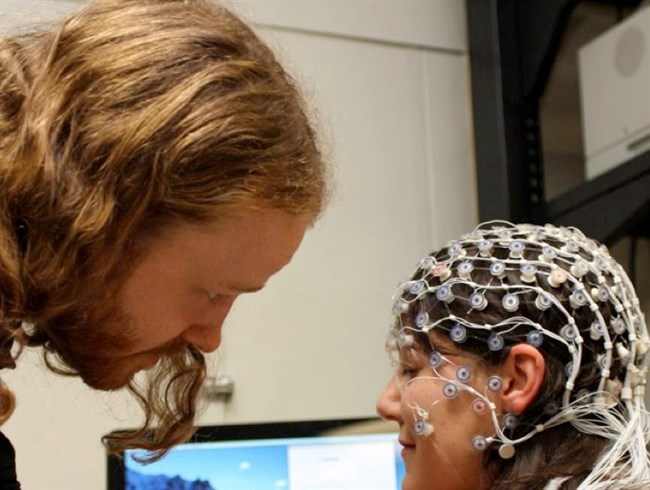TORONTO - A team of researchers is questioning the findings of a highly publicized study that claimed bedside EEG testing showed evidence of conscious awareness in three patients diagnosed as being in a vegetative state.
That study, published two years ago in the prestigious medical journal the Lancet, was conducted by neuroscientist Adrian Owen, post-doctoral fellow Damian Cruse and colleagues at Western University's Centre for Brain and Mind in London, Ont., in collaboration with Cambridge University in the U.K. and the University of Liege in Belgium.
Patients in a vegetative state, usually caused by a brain injury, appear awake but cannot communicate and seem to have no conscious awareness.
Owen's team used an EEG, or electroencephalography, machine to look for awareness in 16 vegetative patients based on brain signals generated by two mental-imagery tasks they were asked to perform — making their right hand into a fist, followed by a separate request to wiggle their toes.
EEG patterns picked up from separate parts of the brain in three of the 16 patients suggested they had understood the requests and performed the tasks. They repeatedly generated electrical brain activity that matched responses seen in healthy volunteers, the study said.
But researchers at Weill Cornell Medical College in New York have challenged the interpretation by Owen's team that the brain-wave patterns indicate conscious awareness in these patients, saying the study was flawed.
They outline their concerns in a letter in this week's issue of the Lancet, accompanied by a response from Owen, Cruse and colleagues, in which they stand by their findings.
The U.S. researchers re-analyzed the data, provided by Owen's team, and concluded the method used and the way findings were analyzed made it impossible to determine whether the vegetative patients were actually aware or not.
"Sadly, our re-analysis of the research team's original data shows these particular methods do not work, and it is important that scientists, physicians, and most importantly, the families of severely brain-injured patients understand that the conclusions reached in the original study were most likely due to chance findings," said principal researcher Dr. Nicholas Schiff.
"We see the urgency and need every single day for tests that can be used to help establish awareness and consciousness in brain-injured patients," the neurologist said in a statement. "However we won't help patients or their families by using a flawed research method and data that cannot accurately provide the information we are all hoping to find."
Co-author Dr. Andrew Goldfine said the re-analysis suggests the brain activity patterns exhibited by the three patients were contaminated by electrical signals caused by muscle movements unrelated to the imagined tasks.
"So we saw in the patients a mixture of muscle activity and brain activity," Goldfine said from New York.
When the researchers tested patients using a more standard method of analysis, their results were vastly different, the Weill Cornell neurologist said.
"In the (healthy) normals, you see this beautiful pattern where when they're imagining moving their hands, you see the hand area of the brain change in activation and when they're imagining moving their feet, you see a change in the feet area of their brain, in most of the normals, not all," he explained.
"In the (vegetative) patients, you see a totally blank map."
Goldfine said the quibble isn't with the idea of using EEG to detect awareness. If a reliable, well-tested method is found, it would be a breakthrough in ascertaining whether a vegetative patient is able to perform cognitive tasks and therefore be "aware," he said.
"So mainly we want to get across the point that this method is not ready to be used," he said. "And in a case where it's a life-or-death decision like, 'Oh, we're going to keep my father alive because this test says he's conscious,' you've got to make sure that it's really valid."
Goldfine stressed the criticism is of the EEG study only, not other research done by Owen's group using a sophisticated form of hospital-based brain imaging, called functional MRI, to detect awareness through neural activity in this patient population.
Both Owen and Cruse declined to be interviewed, but in their response published in the Lancet, they defended how the research was conducted, their methods for analyzing the EEG data and their conclusion that three patients showed evidence of cognitive awareness based on testing.
The team said that independent testing, which included functional MRI imaging showing areas of brain activation in response to a task request, is available for two of the three patients.
"These data confirm that these patients were aware during the same week in which the EEG data in question was acquired," reads the response.
The scientists said their goal is the same as that of the Weill Cornell researchers — to find a way of determining at the bedside whether vegetative patients have conscious awareness, even though they are unable to tell their loved ones or physicians.
"Clearly, it is only through the continuing improvement of our complementary approaches that we will converge upon the optimal methods for accurately identifying covert awareness, where it exists, in every severely brain-injured patient," they write.


